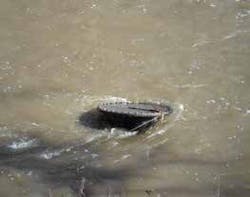Victor Valley Turns to Xylem to Recover from Mojave Desert Environmental Catastrophe
During any given year, average rainfall in the Victor Valley of Southern California is approximately five inches. But 2010 wasn’t the average year. Five storms in December 2010 dropped one year’s worth of rain – more than five inches – in just one week, unleashing a chain of events that overwhelmed systems and wreaked havoc throughout the area.
Pushed beyond the limits of its banks, the Mojave River gushed at more than 36-cubic-feet-per-second (CFS) in the Upper Mojave Narrows. The main sewer interceptor beneath the river became dislodged, causing raw sewage to spill over its banks and onto the Mojave Desert. It was an environmental catastrophe and declared a federal emergency by the Federal Emergency Management Agency (FEMA). And it required immediate attention.
Victor Valley Water Reclamation Authority (VVWRA) called in the local Xylem team to address the immediate need and get a temporary bypass in place as quickly as possible. Xylem was onsite first thing the following morning with necessary equipment and personnel to get the project started. After a quick assessment, pumps, piping, and corresponding accessories were mobilized on the job site. Working 24/7, the complete bypass was designed and installed, and the team was able to stop the flow of raw sewage nine days later.
“We had to mobilize 5,000 feet of HDPE [high-density polyethylene] pipe from Colorado, over 500 miles away,” says Logan Olds, General Manager at VVWRA. “Once it got here, we then had to fuse the pipe, build the bridge across the Mojave River and install the two pumping stations. Xylem and our other vendor partners came through for us in a big way; nine days was nothing short of miraculous.”
Solution
The Upper Narrows bypass encompassed two distinct components. On the Victorville side of the project, there was a 36-inch sewer main with 7 million gallons per day (MGD) of flow that had to be bypassed. To serve this site, the Xylem team brought in two Godwin Dri-Prime CD400M diesel drive pump-sets that pushed flow into a 21-inch, nearly one-mile long HDPE discharge line. One of the CD400M pumps could handle the full flow, with the second pump standing by as a redundant mechanical back-up. Since the 21-inch discharge line ran along the Burlington Northern Santa Fe railroad tracks, crews had to balance getting the bypass installed and keeping the tracks clear for ongoing train activity.
On the Apple Valley side of the river, the bypass had to replace an 18-inch line that carried 3 million gallons per day of flow. Xylem installed a Godwin Dri-Prime CD225M diesel drive pump-set capable of discharging the entire flow into a 16-inch HDPE line that ran for approximately half a mile. Following the blueprint in Victorville, a second CD225M was installed as a redundant mechanical back-up for this part of the bypass. Since the 16-inch line had to traverse the Mojave River, VVWRA brought in Apply Valley Construction and McBratney Company to build a bridge across the river to support the 16-inch HDPE discharge.
Both temporary bypass lines directed the flow back into the force main leading to the treatment plant, and both were set up with level transducers to automatically trigger the back-up pump-sets at pre-determined fluid levels. This precaution provided tremendous peace of mind for the VVWRA teams, who were rightfully concerned about further environmental impact with the project. The natural, historic and environmental obstacles that had to be circumvented and addressed in this project were as challenging as the installation itself. From train tracks to ancient burial grounds, the teams had their hands full getting the piping where it needed to go.
Results
What began as a quick temporary bypass to address the sewage effluent in the Mojave Desert turned into a five-year engagement. During the course of the long-term project, Xylem personnel were onsite a minimum of every 10 days to service all four pumps – providing everything from basic oil changes to troubleshooting any issues. The bypass project also benefited from a 24-hour “pump watch” regimen that ensured the project ran smoothly and without issue. Having personnel on-site and around the clock was another component of the project that provided added peace of mind to VVWRA for the life of the bypass project.
In summarizing the Xylem support on the project, Logan Olds says, “We are grateful for the efforts of the Xylem team on this entire project. Teams were onsite from day one, as soon as it happened, and they’ve been a great partner ever since. Their industry expertise and professionalism over the past five years has been a tremendous asset to me and to the rest of the VVWRA team.”
Editor's Note: Scranton Gillette Communications and the SGC Water Group are not liable for the accuracy, efficacy and validity of the claims made in this piece. The views expressed in this content do not reflect the position of the editorial teams of Water & Wastes Digest, Water Quality Products and Storm Water Solutions.

